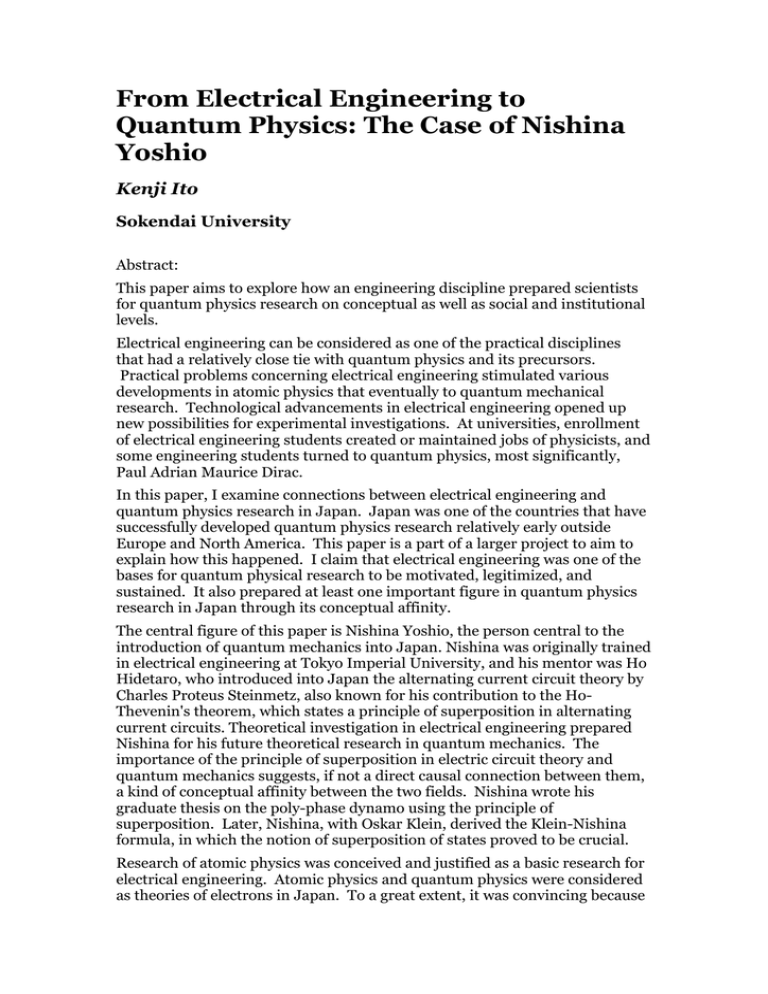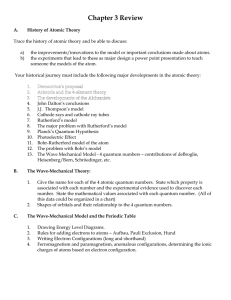From Electrical Engineering to Quantum Physics: The Case of
advertisement

From Electrical Engineering to Quantum Physics: The Case of Nishina Yoshio Kenji Ito Sokendai University Abstract: This paper aims to explore how an engineering discipline prepared scientists for quantum physics research on conceptual as well as social and institutional levels. Electrical engineering can be considered as one of the practical disciplines that had a relatively close tie with quantum physics and its precursors. Practical problems concerning electrical engineering stimulated various developments in atomic physics that eventually to quantum mechanical research. Technological advancements in electrical engineering opened up new possibilities for experimental investigations. At universities, enrollment of electrical engineering students created or maintained jobs of physicists, and some engineering students turned to quantum physics, most significantly, Paul Adrian Maurice Dirac. In this paper, I examine connections between electrical engineering and quantum physics research in Japan. Japan was one of the countries that have successfully developed quantum physics research relatively early outside Europe and North America. This paper is a part of a larger project to aim to explain how this happened. I claim that electrical engineering was one of the bases for quantum physical research to be motivated, legitimized, and sustained. It also prepared at least one important figure in quantum physics research in Japan through its conceptual affinity. The central figure of this paper is Nishina Yoshio, the person central to the introduction of quantum mechanics into Japan. Nishina was originally trained in electrical engineering at Tokyo Imperial University, and his mentor was Ho Hidetaro, who introduced into Japan the alternating current circuit theory by Charles Proteus Steinmetz, also known for his contribution to the HoThevenin's theorem, which states a principle of superposition in alternating current circuits. Theoretical investigation in electrical engineering prepared Nishina for his future theoretical research in quantum mechanics. The importance of the principle of superposition in electric circuit theory and quantum mechanics suggests, if not a direct causal connection between them, a kind of conceptual affinity between the two fields. Nishina wrote his graduate thesis on the poly-phase dynamo using the principle of superposition. Later, Nishina, with Oskar Klein, derived the Klein-Nishina formula, in which the notion of superposition of states proved to be crucial. Research of atomic physics was conceived and justified as a basic research for electrical engineering. Atomic physics and quantum physics were considered as theories of electrons in Japan. To a great extent, it was convincing because quantum physics could be considered as mainly about the behavior of electrons. Atomic physics, thus, could have social legitimization through its connection to electrical engineering, which could be seen essential to the country's industrial developments. First trained in electrical engineering, Nishina probably became interested in atomic physics as a foundation of electrical engineering. It was also a justification to study atomic physics, because electrical engineering was a useful discipline, if atomic physics itself was not. It justified his long absence to study abroad in Europe for his family. It legitimized the discipline itself, because atomic physics itself did not show much utility at this point.




